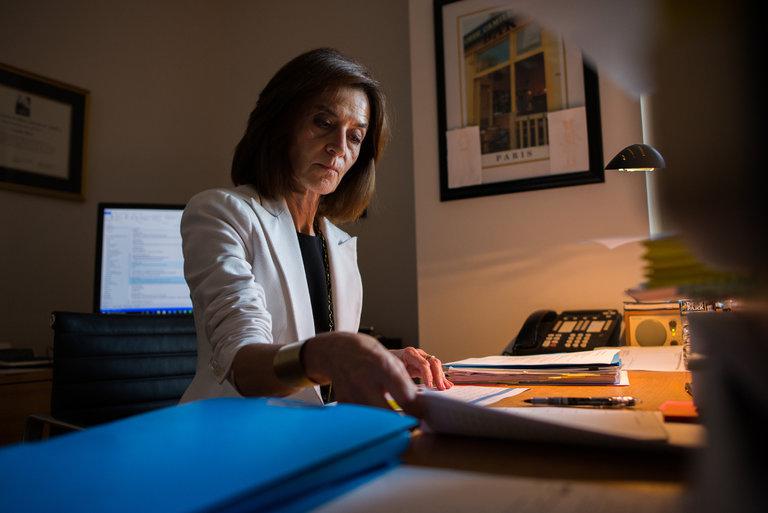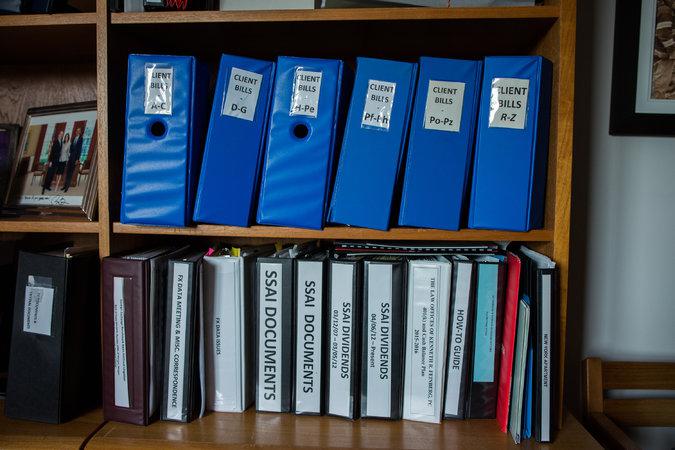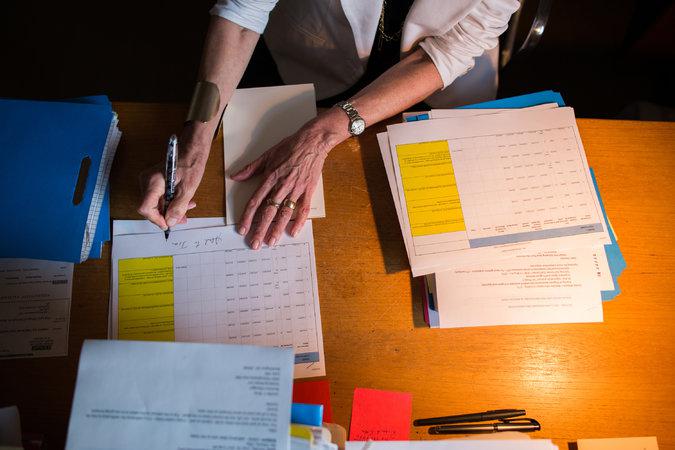|
From 9/11 to Orlando, Ken Feinberg’s Alter Ego in Compensating Victims
By Roger Parloff
New York Times
June 23, 2017
https://www.nytimes.com/2017/06/23/business/ken-feinberg-compensation-fund.html?mcubz=2&_r=0
 |
| Camille Biros at work. She has helped determine compensation in some high-profile cases, such as the Pulse nightclub shooting in Orlando, Fla., and the Deepwater Horizon oil spill. |
 |
| Client bills and other documents in Ms. Biros’s office in Washington. |
 |
| Many steps are involved in establishing a compensation protocol. Many hurdles, too. |
When the Roman Catholic Diocese of Brooklyn unveiled a program on Thursday to compensate victims of sexual abuse by its clergy, it chose a familiar name to oversee it: Kenneth R. Feinberg.
His six-person law firm has achieved national renown — and a near monopoly — in the curious business of devising ways to compensate disaster victims. He administered the September 11th Victim Compensation Fund and the payouts tied to the BP Deepwater Horizon oil spill between 2010 and 2012. More than 30 years ago, he set up the compensation program for American soldiers injured by Agent Orange, the noxious Vietnam War-era defoliant.
Yet the person who actually grapples with many of the most wrenching decisions in carrying out the compensation — Who is eligible? If someone died, who gets the money? — is rarely Mr. Feinberg himself.
Instead, it is Camille Biros. “I don’t think anyone could have anticipated a career like this,” said Ms. Biros, who has worked with the Feinberg firm for nearly 40 years.
Ms. Biros is not a lawyer. Her background is in business administration, and she doubles as the business manager for the firm. In contrast with her bigger-than-life boss, she is low-key and matter-of-fact. “Camille has a quiet reserve that does not invite a lot of casual socializing,” said Mayanne Downs, the city attorney of Orlando, Fla., who helped choose Feinberg to distribute charitable funds to victims of last year’s Pulse nightclub massacre.
In the past 16 years, Ms. Biros has quietly handed out $15.4 billion to thousands of victims of shootings, car crashes, pollution, sexual abuse and terrorist attacks. “There’s me,” said Mr. Feinberg, “and there’s Camille. And that’s basically it.”
The goal with many of these payments is grounded in stark financial reality: Offer victims enough compensation quickly enough, and they will agree not to sue. But the cases can be emotional and vexing.
And there are unexpected curve balls. How do you handle a case — such as the Orlando shooting — in which the parents of several victims who died didn’t want to acknowledge their children’s same-sex partners? In situations like those, who should receive the compensation?
Ms. Biros, 68, was born into an Italian family in Canarsie, Brooklyn, in 1949. She moved to Toms River, N.J., when she was 13. Her father was a shoemaker and, later, a maintenance worker at Ciba-Geigy, while her mother was a homemaker and sometime seamstress. In 1972 she married Mark J. Biros, a law student at the time, and moved to Washington. (He is a partner at the law firm Proskauer Rose. They have two children and two grandchildren.)
In 1979 she got a job as the administrative assistant to Mr. Feinberg, who was then Senator Edward M. Kennedy’s chief of staff. The next year she followed Mr. Feinberg when he left to found the Washington office of Kaye Scholer, a major law firm. She accompanied him again, in 1992, when he went off to found his own law office, specializing in arbitration and mediation.
The first claims project Ms. Biros worked on was the Sept. 11 compensation fund.
The projects break down into two broad categories: those that the firm is paid to devise — for instance, with the Catholic Church clergy-abuse cases — and those done pro bono. Those have included such matters as the Pulse nightclub shooting, which involved the distribution of charitable donations.
“Whatever the issue is,” Ms. Biros said, “Ken and I brainstorm and come up with what we think is an appropriate protocol.” Those plans must be approved by the paying client, but after that the client has no authority over how the program is administered.
The research can be complex. In the system set up in 2014 to compensate victims of defective General Motors ignition switches, which led to 124 deaths and 275 injuries, the process started by researching what juries were awarding in similar cases, Ms. Biros said. Based on those findings, they decided the starting point would be $1 million for a death, plus $300,000 for a spouse and each child. Then, on top of that, economic modelers would compute a projected economic loss — in other words, estimating what the deceased would have earned if not for the catastrophe.
In cases in which people suffered life-altering injuries like brain damage or paralysis, the victims’ lawyer and she would each hire a “life-care planner” to compute the costs of a lifetime of home care, transportation, home renovations for access, and so on. “We’d go through line by line,” she said.
Robert Hilliard of Corpus Christi, Tex., a lawyer who represented ignition-switch victims both in court and before the Feinberg-administered fund, said his clients’ awards ranged from about $10,000 to close to $40 million. Some awards were greater than he could have gotten in court, he said, while some were smaller, although he added, “not that much less.”
Ms. Biros said that deciding whether a defective ignition switch had, in fact, played a role in an accident could be excruciating. Sometimes she and other analysts would pore over photos of a particular accident taped around a conference room, trying to determine whether the airbag had deployed. (The defect caused electrical failure, and an airbag deploys only if the electrical system is working. So if a bag deployed, the claim was ineligible.)
A program started by the New York Archdiocese in October to compensate sexual abuse victims — also administered by Feinberg, and the template for the Brooklyn Diocese program — presented a different set of challenges. In devising a protocol, Ms. Biros said she and Mr. Feinberg weighed an array of factors. Among them: “How old was the child when they actually started molesting them? How often? I know this sounds horrible. Was it one time, or did this go on for years? What type of abuse — what they actually did?”
She declined to comment on how the factors translated into compensatory sums, citing the archdiocese’s confidentiality restrictions.
J. Michael Reck, a lawyer for victims of sexual abuse by members of the clergy, said the awards available from the New York Archdiocese program “are significantly less than would be considered full justice in the court system.” Seven of his clients have received sums ranging from about $150,000 to $350,000, he said, and he is still pursuing cases for about a dozen more. Plaintiffs in the diocese cases cannot, as a practical matter, sue in court because the statute of limitations has passed.
A particularly painful aspect of the diocese claims, Ms. Biros said, was witnessing the intensity of the victims’ pain despite the passage of time. In nearly every Feinberg-administered program, victims are given an opportunity for a hearing — to make their case, to make a statement, to vent. “The surprising thing,” she says, “or maybe not so surprising, if you really know about what happens to these individuals, is they’re sitting there 20 or 30 years later, and they’ll be sobbing.”
A recurring and often overlooked challenge of Ms. Biros’s job involves the knotty issue, which arises in every death case, of who gets the compensation. Ms. Biros said the programs typically ask to see a plan to split the money “that is prepared by the personal representative and that gets sign-off from every legal heir based on state law.”
If Ms. Biros can’t get that, she warns that she’ll have to deposit the sum with the probate court until the family can reach a resolution. “That moves a lot of people to come to agreement,” Ms. Biros noted, “because it takes forever to get it through the probate court.”
The charitable fund administered for the Pulse nightclub victims presented a variation on this theme. Many victims had same-sex partners, but had never married — an option that had only just become legal in Florida a year earlier. “There were families who refused to acknowledge the relationship,” Ms. Biros said.
“Ken and I spoke with the partners and the parents in these cases,” she continued, “and we ultimately secured agreement with a split of compensation — something like 75 percent to the parents, 25 percent to the partner.”
Though the Feinberg firm’s compensation is in most cases confidential, its noncharitable projects appear to pay well. At the height of the BP Deep Horizon project, the firm — which then consisted of three lawyers and about five staff members — was receiving $1.25 million per month.
Pro bono projects tend to be far simpler. Recipients don’t have to waive any rights, they receive no payment for economic loss, and the size of the awards in each category depends largely on how much money was donated.
For instance, One Fund Boston, created after the Boston Marathon bombing in 2013, paid each decedent’s family nearly $2.2 million. A fund set up after the 2007 shootings at Virginia Tech paid each decedent’s family $208,000.
For three of the charitable funds for which it devised protocols, the firm also recommended small payments to people who were “present on site,” in recognition of their mental anguish. Payments like these went to people at the Pulse nightclub who escaped “by stepping over the friends’ bodies, ” Ms. Biros said, or “students hiding under their desks in the actual classroom where the crazy gunman was” during the Virginia Tech rampage.
Despite decades of experience, unexpected obstacles pop up. In the Deepwater Horizon case, which made $6.5 billion in payments to nearly a quarter-million people and businesses, it turned out that a number of individual recipients “were in tremendous arrears in child and family support,” she said. That was “one of things we were stunned by.”
As a result, more than 30 states imposed, in effect, liens on those victims’ compensation payments. “In a lot of cases,” Ms. Biros recalled, “these people ended up being zeroed out.” In other words, all the compensation went toward their unpaid child-support obligations.
|


